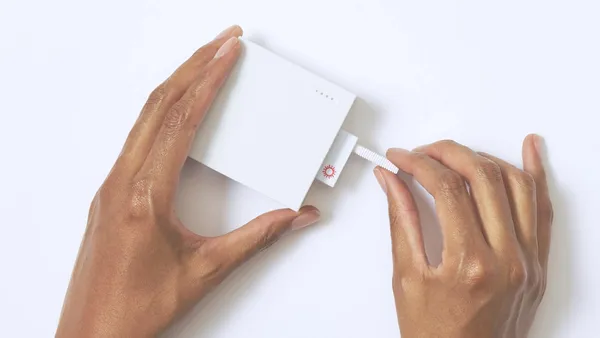Dive Brief:
- FDA said it authorized a record 132 novel medical devices in 2020, boosted by emergency use authorizations for tests and sample collection devices, personal protective equipment and ventilators that saw demand swell during the country's response to the spread of COVID-19.
- The number has trended upward over the past decade despite a dip in 2019, when just 71 new devices were authorized. The 2020 tally tops the 106 novel device authorizations in 2018 that marked a 40-year high, agency leaders said in a blog post.
- Many device "firsts" in 2020 were unrelated to COVID-19, including an anterior cruciate ligament implant, a continuous renal replacement therapy device and a game-based digital therapeutic designed to help children with attention deficit hyperactivity disorder, among several others, said FDA's Jeff Shuren, director of the Center for Devices and Radiological Health, and William Maisel, director of the CDRH's Office of Product Evaluation and Quality.
Dive Insight:
The COVID-19 pandemic saw the CDRH's resources stretched thin as the center grappled not only with a deluge of EUAs but also an influx of non-coronavirus submissions equal to or exceeding the levels of previous years, Shuren said in December. Managing the expanded workload resulted in some bumps in the process of accelerating product evaluations, the agency has admitted.
Writing this week in the New England Journal of Medicine, Shuren and Timothy Stenzel, director of the Office of In Vitro Diagnostics and Radiological Health, said FDA's early policy of allowing COVID-19 antibody tests to come to market without undergoing regulatory review led to a flood of poorly performing diagnostics. FDA reversed the policy, removed 225 tests from its website and issued 15 warning letters as it worked to rectify the situation. The experience underscored the importance of authorization and has spurred the agency to explore new strategies for speeding test assessment, Shuren and Stenzel said.
In their blog post looking back at the year, Shuren and Maisel said novel devices include those brought to market through the PMA, humanitarian device exemption and De Novo pathways, as well as those that receive 510(k) clearance or emergency use authorization.
Of the thousands of 510(k) clearances every year, FDA considers only devices with a breakthrough designation to be novel, Shuren and Maisel said. Novel devices address an unmet need, or may be safer or more effective than currently available alternatives.
Shuren and Maisel said the agency issued 625 EUAs for medical devices in 2020, including several designated as novel medical devices such as in vitro diagnostics for COVID-19.
Other novel devices unrelated to the pandemic authorized in 2020 include the first liquid biopsy next-generation-sequencing companion diagnostic test, the first cardiac ultrasound software using artificial intelligence to aid in capturing quality diagnostic images, and an automated insulin delivery and monitoring system for use in young patients, they noted.
Shuren and Maisel said the agency also continues to work through the Breakthrough Devices Program, which has granted the designation to more than 400 devices to date. FDA has now approved, authorized or cleared 23 breakthrough devices through the PMA, De Novo or 510(k) pathway, they added.










